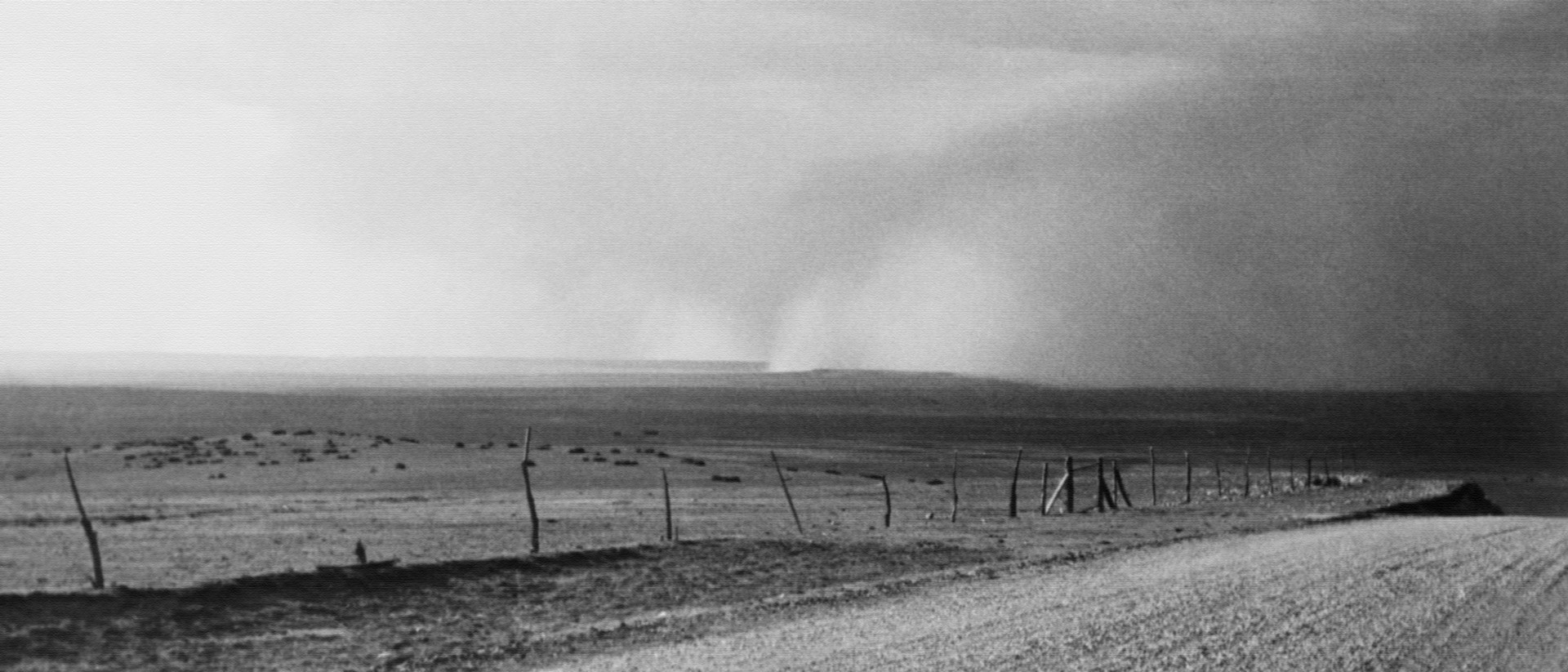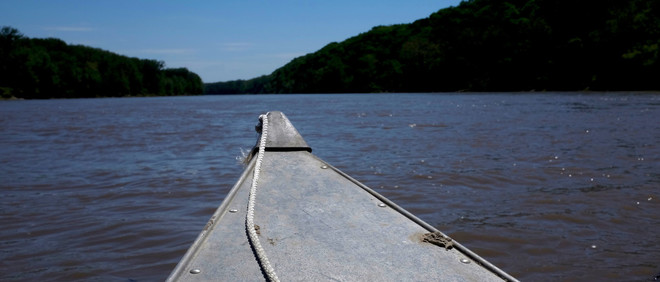In Alton, Illinois, a small town across the Mississippi River from St. Louis, Missouri, lies the grave of Elijah Parish Lovejoy. Lovejoy was a journalist who was murdered by a racist mob in 1837.
Lovejoy moved at age 25 to St. Louis, the site of violent clashes over black freedom. Missouri was a slave state surrounded by free states, and most of Lovejoy’s contemporaries favored either a continuation of slave labor or gradual emancipation. Above all, elites wanted to avoid the topic of race entirely. Politicians and editors ordered journalists not to write about slavery, for fear discussion would stoke unrest.
Elijah Parish Lovejoy. Portrait courtesy of Wikimedia Commons
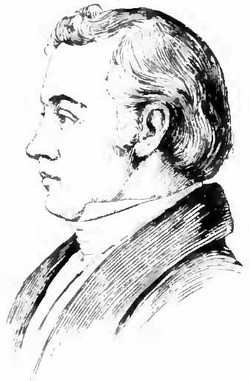
Lovejoy did not comply.
In St. Louis, Lovejoy witnessed a level of brutality toward blacks he had never seen before. After a black man was burned alive by a mob of white men, Lovejoy began writing passionate condemnations of slavery. His words attracted a wide audience which included racist St. Louis mobs. After the mobs repeatedly destroyed his printing materials and threatened his life, Lovejoy fled in 1836 to Alton.
But the mobs followed him. He was greeted at the Alton dock by angry St. Louisans, who threw his printing press into the Mississippi River. Lovejoy continued to publish editorials calling for the immediate end of slavery, and his offices continued to be ransacked and his presses stolen. On November 7, 1837, Lovejoy received his fourth press and hid it in a warehouse, but the mob figured out his location and set the building ablaze. Lovejoy was shot to death as he attempted to escape the flames, and angry white men bypassed his bullet-ridden corpse to seize his printing press, which they smashed and threw into the river for the final time.
The mob attacking the warehouse of Godfrey Gilman & Co. in Alton, Illinois, on the night of November 7, 1837. Image courtesy of Internet Archive Book Images
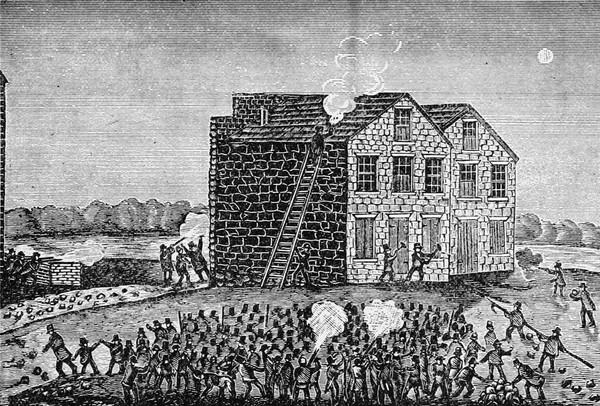
By 1837, Elijah Lovejoy knew he was going to be killed. “If the laws of my country fail to protect me,” he wrote shortly before he was murdered, “I appeal to God, and with him I cheerfully rest my cause. I can die at my post, but I cannot desert it.”
Those words are carved into the monument for Lovejoy in Alton. The monument sits on a hill with a view of the town, the subsequent history of which bears testament to Lovejoy’s legacy. It was in Alton that Abraham Lincoln, influenced by Lovejoy, debated slavery. It was in Alton where James Earl Ray, the killer of Martin Luther King Jr, was born. It was in Alton that the Underground Railroad thrived, symbolic of a region divided not only between whites and blacks, but between whites who fought for black rights and whites who opposed them.
That racial rift remains unresolved today, in Alton and across the river in St. Louis, where I live, as well as throughout the nation as a whole. There are no abstract parallels to draw here, our era is simply a continuation of America’s centuries-old racial crisis, an ongoing tension that occasionally explodes. Especially now, with the election of America’s next president. Especially now that the Ku Klux Klan has endorsed Donald Trump.
Photo from PhotoQuest / Getty Images
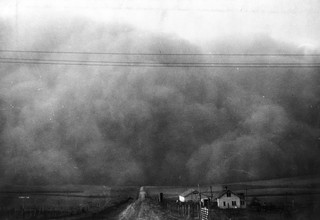
The mobs of today
In 2014, I watched militarized police gas black protesters fighting against police brutality in Ferguson. And in 2016, I watched white Donald Trump supporters and largely non-white anti-Trump protesters fight each other, to the extent that some left covered in blood, outside Trump’s rally in downtown St Louis.
“It is because I fear God that l am not afraid of all who oppose me in this city”
That was the day I watched a crowd become a mob – a mob that waited politely in line but screamed racial epithets when challenged by those who opposed Trump, a mob whose members spoke of forming white supremacist militias if Trump lost.
“It is because I fear God that l am not afraid of all who oppose me in this city,” Elijah Lovejoy proclaimed in 1837. “If I fall, my grave shall be made in Alton.”
In October, I visited Lovejoy’s monument, contemplating the election. To Lovejoy, the greatest threat was not death, but the abdication of one’s principles – the selfishness of self-preservation in an era of mob rule. That is the clarity of conscience that bides your time to the grave.
Lovejoy died on November 7. He was born on November 9. In between Elijah Lovejoy’s murder and birth lies November 8 – Election Day.
The link with Trump
Today, Elijah Lovejoy is known as a martyr of free speech. But his greatest legacy is not that he dared speak, but what he dared to say. The press has no true power if it is afraid to document attacks on the most vulnerable citizens, and to challenge those who abet such attacks. Today, journalists cope with multiple fears: fear of maintaining employment in a terrible economy; fear of losing access to powerful elites through criticism; and fear of the mob, a fear openly expressed by writers who are targeted by Trump fans. While journalists who cover Clinton also face criticism and are sometimes mocked by her supporters, they are not subjected to the type of racist threats that Trump fans make; nor does Clinton encourage her fans to engage in this behavior.
Fox News, always a pulpit for the right, has continued to prop up Trump, but what’s surprising is how indistinguishable Fox has become from other networks
Over the past year, many journalists have detailed threats made by Trump supporters, many of them white supremacists and anti-Semites. Journalists have been sent photoshopped pictures of themselves in gas chambers or shot in the head, and have had their family members threatened. These threats are openly encouraged by Trump, who has declared the press his enemy and has threatened to sue journalists and publishers.
Yet despite the threats the press face, a strange concurrent phenomenon is occurring: the propping up of Trump by the very media establishment he claims opposes him, and whom he ceaselessly demonizes. Cable news is the worst offender: Trump has been given more airtime than any other candidate, and retains close ties with several network heads, including CNN’s Jeff Zucker, who keeps a framed Trump tweet on his wall. Zucker hired Corey Lewandowski, Trump’s former campaign manager, as a paid commentator as he was simultaneously being paid by Trump: an arrangement you usually see in dictatorships. CNN also hired surrogates whose job is to defend Trump, often by echoing his racist views.
The other cable networks are no better. As Trump rose in popularity, MSNBC fired many of its non-white hosts, who were likely to protest his racism, and features a program, “Morning Joe,” whose hosts have promoted Trump after Trump threatened to spill secrets about them. Fox News, always a pulpit for the right, has continued to prop up Trump, but what’s surprising is how indistinguishable Fox has become from other networks.
All news networks ride the financially lucrative Trump train despite his attacks on the very nature of a free press. As I write this article, the US media is breathlessly covering a new Trump hotel: this is what dominates American news in a time of vitriol and violence. That hotel is Trump’s priority, and apparently it is that of much of the media as well.
But it is not the priority of Trump’s fans. Trump’s hardcore white supremacist base has other goals, and as they emerge, one has to ask why they are not getting more attention.
Photo from Corbis via Getty Images

The list is endless
On October 14, three white supremacist terrorists were arrested in Kansas for building a weapon of mass destruction that they planned to use the day after Election Day to blow up an apartment complex housing Somali immigrants. Boasting that they did not care if the attacks killed children, the men, who claim they are members of a militia, were supporters of Trump, and one even quoted a promise from Trump’s campaign manager, Roger Stone, that a “bloodbath” was coming for Election Day.
The men also planned to bomb a mosque, making them one of three cases of Trump fans arrested for planning mosque attacks. “I’ll follow this MAN to the end of the world,” boasted a 55-year-old California Trump fan before he was arrested in December 2015 for building a bomb in his home.
Another California man was arrested on October 26 for plotting a mass shooting at a local mosque. That man, Mark Feigin, is a Trump supporter who had previously sent anti-Muslim tweets to Muslim rights activists like Imraan Siddiqi, who noted wryly: “That would mark the first known time one of my trolls got arrested on a terror charge.” As you can see, the threats of Trump fans are open, blatant – and often dismissed as ‘just trolling.’
Across the country, states are struggling with how to contend with the voter intimidation that Trump and his supporters have announced will take place. In Colorado, poll workers are being trained on how to handle a mass shooting on Election Day. In Virginia, armed Trump fans camped out in front of a female candidate’s office, an act of intimidation reminiscent of the vitriol prior to the attempted assassination of Arizona congresswoman Gabby Giffords in 2011.
In Ohio, Trump fans have announced their plan to harass non-white voters, which is illegal: “I’ll look for ... well, it’s called racial profiling,” explained Trump supporter Steve Webb of Ohio. “Mexicans. Syrians. People who can’t speak American. I’m going to go right up behind them. I’ll do everything legally. I want to see if they are accountable. I’m not going to do anything illegal. I’m going to make them a little bit nervous.”
I could go on and on, listing other incidents and threats. None of them are surprising: homegrown terrorism – in the form of white supremacist groups and ‘patriot’ militias – has been on the rise sharply since 2008, and there have been numerous attacks on non-white citizens and women by Trump supporters since his campaign launched in June 2015.
Photo from the Universal History Archive / UIG via Getty Images
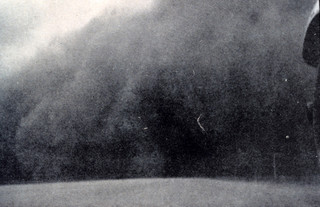
The role of the media
But aside from a few lengthy studies by experts on white nationalism and homegrown terrorism, the media largely downplays the threat, and some mainstream outlets have even written puff pieces this week glamorizing white supremacist leaders. White men who plot to blow things up are rarely called ‘terrorists’ in headlines but are instead referred to by their preferred nomenclature ‘militia.’ It is difficult to conceive of the Kansas bomb plot being portrayed in such a way if the situation were reversed, and a group of Muslim Somalis had plotted to blow up an apartment of white Kansans.
This dereliction of duty has two dire consequences: first, it leaves citizens unaware of what’s happening and unprepared for homegrown violence that may come; second, it exemplifies and enables Trump’s logic of racial superiority by treating threats to the lives of non-white, non-Christian citizens as unimportant and inconsequential.
In the 1990s, white domestic terrorists were designated as such: the Oklahoma City bomber Timothy McVeigh, the ‘Unabomber’ Ted Kaczynski, the Atlanta Olympics bomber Eric Rudolph. These men committed acts of mass violence to make a political point, the very definition of terrorism. But there has been a reluctance to label white men as terrorists since 9/11, when that label became tied – and then limited – to Islamic militancy. This is despite the fact that the FBI sees domestic terrorism, often initiated by white supremacist groups, as a bigger threat to American safety than foreign terrorism.
In a way, the nature of white terrorism today harkens back to the era of Lovejoy, when white supremacy was an overt creed, the mobs of white men who targeted non-whites were never punished, and the press was too afraid to discuss it. The white supremacist terrorists targeting Muslims and immigrants today are the descendants of that tradition, and in order for the phenomenon to be fought, it needs to be examined in depth.
Photo from the Everett Collection / Hollandse Hoogte
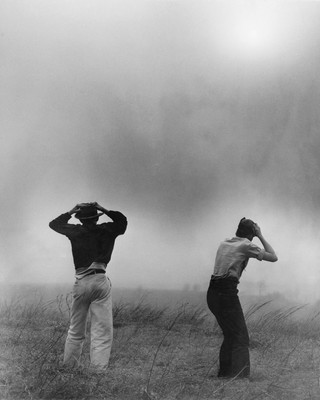
The tyranny of the mob
It is a terrible feeling to sense a threat coming, and know that many are abetting it by promoting the man who propels it. It is worse when the threat reveals itself to be real, yet complacency remains, and you do not know whether this reaction is rooted in apathy or cowardice. Cowardice toward Trump has been epic: in the media, among the GOP, and even in organizations like the American Bar Association, who last week studied Trump’s use of lawsuits to silence opponents, then refused to publish the study out of fear he would sue them. While in recent months journalists have run critical coverage of Trump, most dismissed him as a joke or indulged him before and during the primaries, facilitating his rise. His fellow Republicans, even when they criticize him, still endorse him.
The same phenomenon is taking place all over the Western world, as demagogic white nationalists rise, elites falsely predict their loss or play down the ramifications of their win, and hate crimes explode once victory is achieved, as witnessed in post-Brexit UK. It was all predictable, but now there is no clear organized process to stop it. Instead, victimized populations wait for their hardship to be taken seriously, and wait, and wait. Meanwhile, in the confusion and inertia, white nationalists consolidate their power.
The tyranny of the mob is enabled by those who refuse to recognize the threat and who avoid discussion of the racial enmity at its core
I do not know what kind of America I will wake up to November 9. But I know that the result of the election does not hinge on Election Day. What happens to the US will be the cumulative effect of a campaign that has mainstreamed bigotry and is now mainstreaming – or at least severely playing down – white supremacist violence.
Trump never specified what era he was referring to when he said he would “Make America Great Again.” Many assumed it was the 1950s, when job growth for whites was high and civil rights were denied. But when I visit Lovejoy’s grave across the river, I am reminded of life in St. Louis in the 1830s, of the mob violence that preceded the Civil War, of the way Lovejoy tried to convince people that non-whites were human and white mobs were a dangerous problem, and how he anticipated his own death as a result of these toxic politics. His era was one in which white men could attack non-whites with impunity, and those who defied them faced terrifying consequences. It would have been a great era to be Donald Trump.
The tyranny of the mob is enabled by those who refuse to recognize the threat, who rationalize the mob’s aims, or who – like the elites of the 1830s – avoid discussion of the racial enmity at its core. That same deep denial is occurring today, over 180 years later. We have a moral obligation to oppose it and document it, as others have in dangerous eras, in the hopes of negating threats to the most vulnerable.
As Lovejoy proclaimed, there is no excuse for deserting your post.
Photo from Corbis via Getty Images
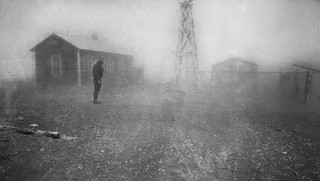
More from De Correspondent:

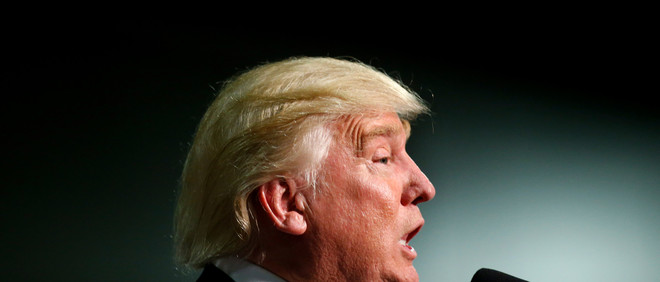 To Donald Trump, we are all bit players in a fantasy America starring Donald Trump
In Trump’s worldview, there are no middle or upper-class black citizens, only a horde of jobless, uneducated Americans fighting for survival amid the urban blight. His latest comments are the clearest evidence yet that Trump has no respect for the actual inhabitants of actual places. How can a man who’s been traveling the country all year still know so little about its people?
To Donald Trump, we are all bit players in a fantasy America starring Donald Trump
In Trump’s worldview, there are no middle or upper-class black citizens, only a horde of jobless, uneducated Americans fighting for survival amid the urban blight. His latest comments are the clearest evidence yet that Trump has no respect for the actual inhabitants of actual places. How can a man who’s been traveling the country all year still know so little about its people?
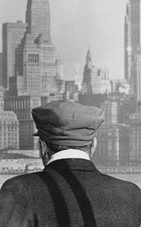
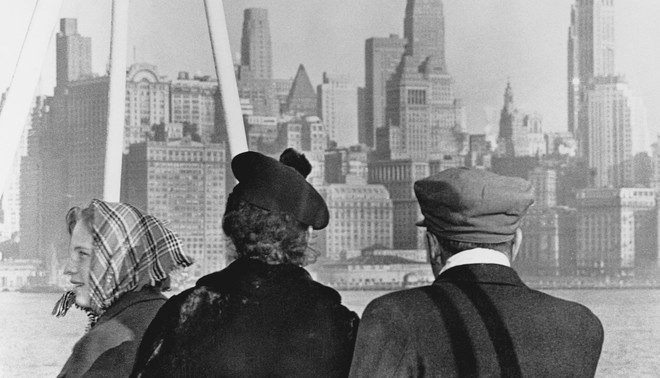 How do you become “white” in America?
Trump has retweeted white supremacist groups and has the backing of the Ku Klux Klan. He uses whiteness as a weapon, and his candidacy on a major party ticket threatens to put the country back some 200 years. What does Trump’s vision of whiteness mean for a diverse country like the U.S.?
How do you become “white” in America?
Trump has retweeted white supremacist groups and has the backing of the Ku Klux Klan. He uses whiteness as a weapon, and his candidacy on a major party ticket threatens to put the country back some 200 years. What does Trump’s vision of whiteness mean for a diverse country like the U.S.?
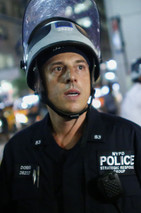
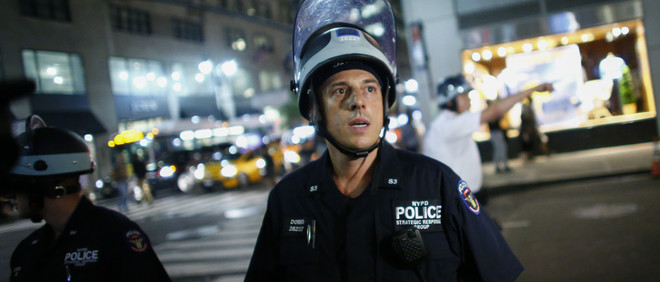 What I had to tell my daughter about the America of her black classmates
For centuries, black Americans have been systematically brutalized. Now that we have video evidence – going viral – you would expect things to change. But even video cannot open the eyes of those who refuse to see.
What I had to tell my daughter about the America of her black classmates
For centuries, black Americans have been systematically brutalized. Now that we have video evidence – going viral – you would expect things to change. But even video cannot open the eyes of those who refuse to see.



